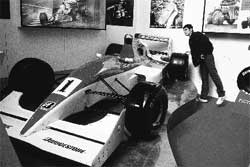Cool, isn t it?
 car radiators could be made the size of a matchbox if only they used a highly efficient heat exchanger developed recently at Bristol University, uk . The exchanger could also be used to build air-breathing engines for hypersonic aircraft (planes that can travel faster than the speed of sound).
car radiators could be made the size of a matchbox if only they used a highly efficient heat exchanger developed recently at Bristol University, uk . The exchanger could also be used to build air-breathing engines for hypersonic aircraft (planes that can travel faster than the speed of sound).
James Murray created the exchanger, which is a thousandth the size of the conventional car radiators, but just as good at cooling gases and liquids. He started on the research project to solve a cooling problem that has held back the development of hypersonic aircraft capable of travelling at speeds of up to Mach five, or five times the speed of sound ( New Scientist , Vol 157, No 2120).
The hypersonic craft would be fuelled by liquid hydrogen. While flying through the atmosphere, the engines would use oxygen from the air to burn the fuel and produce the thrust required. Once the aircraft was clear of the atmosphere it would switch to its own oxygen supplies. British Aerospace was developing an air-breathing engine for a reusable spaceplane, called Hotol, but its funding was terminated nine years ago, in 1989.
Using oxygen from the air means the aircraft needs to carry less fuel while it is gaining height. Rockets burn most of their fuel in the opening minutes of a flight as they fight to overcome gravity and escape the atmospheric drag.
This type of hybrid engine has been proposed as the best way to power a reusable spaceplane that could make the trip from Europe to Australia in two hours flat by flying through space. The big problem is finding a way to cool air that has been heated to extremely high temperatures by the aircraft's speed. The air has to be cooled and compressed before it can be mixed with hydrogen. "At Mach five the air can reach temperatures as high as 1,000
Related Content
- State of the global climate 2023
- India's journey towards sustainable cooling
- Global cooling watch 2023
- Restoring mountain ecosystems: challenges, case studies and recommendations for implementing the UN Decade Principles for Mountain Ecosystem Restoration
- Unlocking floating solar photovoltaics potential in India
- Order of the National Green Tribunal regarding Pariki Cherueu lake pollution, Hyderabad, Telangana, 26/09/2023
